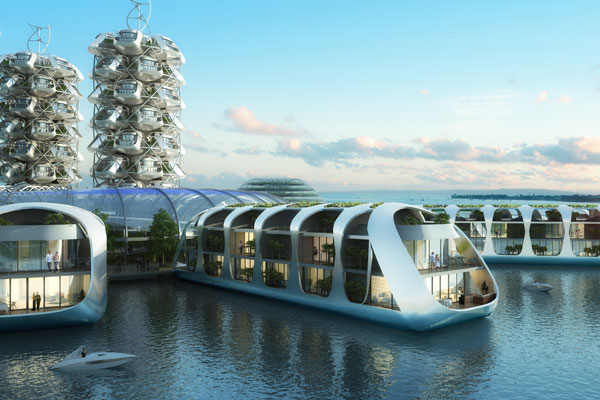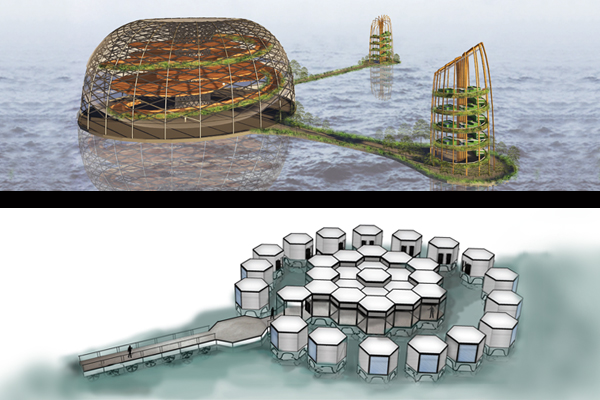In an exhibition on low energy waterborne communities, professor and architect Jason Pomeroy and his students unveil their design solutions for future developments on water. Olha Romaniuk writes.

May 11th, 2016
Top image: Pomeroy Studio’s proposal for Isola La Certosa
Ahead of the release of his latest book titled Pod Off-Grid: Explorations into Low Energy Waterborne Communities, which explores ideas behind self-sustaining, low-energy communities on water, Jason Pomeroy of Pomeroy Studio opened a month-long exhibition on the same subject at the Raffles Design Institute with a design talk that examined the possibilities of waterborne design as a response to rapid urbanisation and sustainability challenges of urban developments. To an audience-filled room, Pomeroy presented the design explorations of his students from last year’s two-week academic workshop in Venice, in which the participants from Raffles Design Institute and other universities investigated new approaches to designing sustainable waterborne communities. As an additional outcome of the Venice workshop, Pomeroy also unveiled his firm’s own concept for a waterborne community at Isola La Certosa near Venice with a vision for a new development anchored in agri-aquaculture and green tourism.

Pomeroy Studio’s proposal for Isola La Certosa
Pomeroy opened the talk with some powerful demographics about global urbanisation. “Since 2007, half of the world’s population has been living in urban areas,” said the architect. “This number will increase to 75% by 2050. Fifty per cent of our global carbon emissions are caused by the built environment, 80% of which are caused by cities.”
As a response to the startling statistics, the Venice workshop titled POG (Pod Off-Grid) and Play or the zero-carbon water-borne community and conducted from January to February 2015 and July 2015 under the supervision of Pomeroy, was conceived as a multidisciplinary think-tank to explore approaches to designing communities that would offer viable alternatives to land urbanisation. Under Pomeroy’s supervision, students from Università IUAV di Venezia (Italy), James Cook University (Australia) and Raffles Design Institute (Singapore) explored opportunities for sustainable solutions applicable to the surrounding context of Venice and rooted in social, economic, environmental, spatial, cultural, and technological parameters.
“We asked students to step outside of their comfort zone and start designing something at a very different scale, in a very different climate and in a very different social environment. We took students out of Singapore and put them in a very ancient, urban museum of nostalgia that is Venice,” explained Pomeroy.

(Top) Lagunatory (bottom) Venice Research Center
Pomeroy’s brief to his students was to create a concept design for a modular waterborne community in Venice that would incorporate an essential kit of parts comprising a city, as set forth by Pomeroy – the Hub, the Spine and the POG (or a pod off-grid). Guided by these parameters, students collaborated on new design ideas to reduce the pressure of higher density developments on land, looking at the issues of urbanisation through a sustainable and contextual lens. The ideas generated during the workshop, though Venice-specific in their programmatic aims, showcased a promise of their adaptability to a variety of waterborne settings around the world.
At the heels of the workshop, Pomeroy and his team at Pomeroy Studio also created their own proposal for the Venice waterfront, identifying current problems within the City of Canals and offering a sustainable solution to support the local economy through agri-aquaculture and green tourism. Rather than altering the historic fabric of the city with new interventions, Pomeroy Studio selected a more remote site for development. Pomeroy and his team reimagined Isola La Certosa – a former military island – as a new hub of green tourism that could serve as a counterpoint to the historic tourism within the cultural sector of San Marco. The proposal, in line with the brief of the Venice workshop, as ideated by Pomeroy, utilised POGs as essential parts of the new development, providing a mix of residential typologies for those working in agri-aquaculture and green tourism to sustain the local community.
Concluding his talk, Pomeroy spoke with optimism about the diverse ideas on self-sustaining waterborne communities generated during the Venice workshop as applicable within different contexts. In Pomeroy’s words, “All these ideas explore how to address the sustainability challenges of tomorrow and can be applied to different waterborne settings around the world. What may be applicable to Venice in 2014 should be able to adapt to Dhaka in 2020.”
Pomeroy Studio
pomeroystudio.sg
A searchable and comprehensive guide for specifying leading products and their suppliers
Keep up to date with the latest and greatest from our industry BFF's!

In the pursuit of an uplifting synergy between the inner world and the surrounding environment, internationally acclaimed Interior Architect and Designer Lorena Gaxiola transform the vibration of the auspicious number ‘8’ into mesmerising artistry alongside the Feltex design team, brought to you by GH Commercial.

Sub-Zero and Wolf’s prestigious Kitchen Design Contest (KDC) has celebrated the very best in kitchen innovation and aesthetics for three decades now. Recognising premier kitchen design professionals from around the globe, the KDC facilitates innovation, style and functionality that pushes boundaries.

Marylou Cafaro’s first trendjournal sparked a powerful, decades-long movement in joinery designs and finishes which eventually saw Australian design develop its independence and characteristic style. Now, polytec offers all-new insights into the future of Australian design.
The internet never sleeps! Here's the stuff you might have missed

Landing in the city’s financial district for the first time, The Sebel Sydney Martin Place has had its modern interiors completed by Stack Studio.

As one of the many entries to The Social Space category at the 2024 INDE.Awards, this community centre is something out of the ordinary through its architectural design, that also provides a place for community and connection for many.